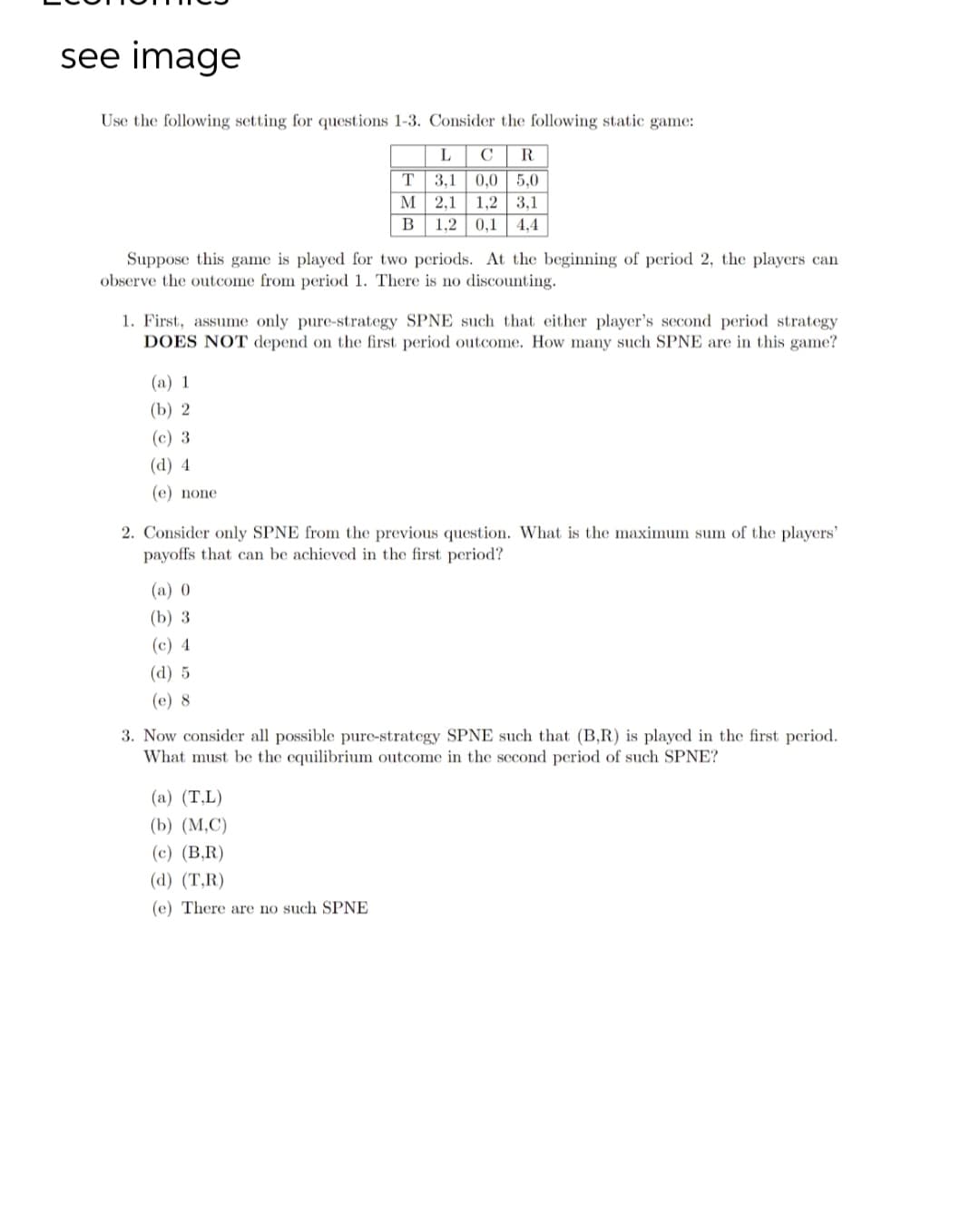Use the following setting for questions 1-3. Consider the following static game: CR L 3,1 0,0 5,0 T M 2,1 1,2 3,1 B 1,2 0,1 4,4 Suppose this game is played for two periods. At the beginning of period 2, the players can observe the outcome from period 1. There is no discounting. 1. First, assume only pure-strategy SPNE such that either player's second period strategy DOES NOT depend on the first period outcome. How many such SPNE are in this game? (a) 1 (b) 2 (c) 3 (d) 4 (e) none
Use the following setting for questions 1-3. Consider the following static game: CR L 3,1 0,0 5,0 T M 2,1 1,2 3,1 B 1,2 0,1 4,4 Suppose this game is played for two periods. At the beginning of period 2, the players can observe the outcome from period 1. There is no discounting. 1. First, assume only pure-strategy SPNE such that either player's second period strategy DOES NOT depend on the first period outcome. How many such SPNE are in this game? (a) 1 (b) 2 (c) 3 (d) 4 (e) none
Chapter8: Game Theory
Section: Chapter Questions
Problem 8.9P
Related questions
Question

Transcribed Image Text:see image
Use the following setting for questions 1-3. Consider the following static game:
C R
L
3,1 0,0 5,0
T
M
2,1 1,2 3,1
B 1.2 0,1 4,4
Suppose this game is played for two periods. At the beginning of period 2, the players can
observe the outcome from period 1. There is no discounting.
1. First, assume only pure-strategy SPNE such that either player's second period strategy
DOES NOT depend on the first period outcome. How many such SPNE are in this game?
(a) 1
(b) 2
(c) 3
(d) 4
(e) none
2. Consider only SPNE from the previous question. What is the maximum sum of the players'
payoffs that can be achieved in the first period?
(a) 0
(b) 3
(c) 4
(d) 5
(e) 8
3. Now consider all possible pure-strategy SPNE such that (B,R) is played in the first period.
What must be the equilibrium outcome in the second period of such SPNE?
(a) (T,L)
(b) (M,C)
(c) (B,R)
(d) (T,R)
(e) There are no such SPNE
Expert Solution
This question has been solved!
Explore an expertly crafted, step-by-step solution for a thorough understanding of key concepts.
This is a popular solution!
Trending now
This is a popular solution!
Step by step
Solved in 3 steps with 1 images

Knowledge Booster
Learn more about
Need a deep-dive on the concept behind this application? Look no further. Learn more about this topic, economics and related others by exploring similar questions and additional content below.Recommended textbooks for you


Managerial Economics: Applications, Strategies an…
Economics
ISBN:
9781305506381
Author:
James R. McGuigan, R. Charles Moyer, Frederick H.deB. Harris
Publisher:
Cengage Learning


Managerial Economics: Applications, Strategies an…
Economics
ISBN:
9781305506381
Author:
James R. McGuigan, R. Charles Moyer, Frederick H.deB. Harris
Publisher:
Cengage Learning